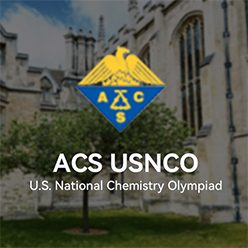我们的USNCO化学竞赛辅导课程配有独家自研教材,授课老师均为海内外名校毕业,具有丰富的竞赛教学经验!
USNCO课程试听
需要辅导课程的同学,可以扫码咨询,然后选择符合您需求的课程进行试听~

USNCO美国化学奥赛辅导课程
考试内容
USNCO美国国家化学奥赛难度介于中学化学和大学化学之间,知识点全面,且以无机化学为主。相比AP化学,USNCO在分子轨道,酸碱平衡,能斯特方程当方面难度加大,对于AP化学中的有机,生化弱项,USNCO亦有要求,总体无机部分占比90%左右,其余为有机和生化部分。此次USNCO课程不仅仅针对USNCO首轮,我们会增加有机内容,对美高学员有额外帮助(美高学员可以晋级第二轮USNCO National),除了冲击奖项外,同样适合AP,IB,Alevel课程学员的学科考试。
适应对象
USNCO美国化学学会 (ACS) 主办,是美国极具影响力的高中化学竞赛
此次USNCO,所有对化学感兴趣的学生均可参加,特别是准备申请美国理工科专业,以及准备明年AP化学大考的学生
课时:50小时
课程大纲
课程结构与进度和学生基础相关,可能会调整
General chemistry 普通化学 Matter,enegy and quantities; Electromagnetic wave 1. Law of conversion of mass 2. Atoms 3. Pure substance & mixture 4. Properties 5. Four fundamental interactions 6. Law of conversion of energy 7. Kinetic energy & heat 8. Potential energy 9. Coulomb's Law 10. Electrostatic force & potential 11. Electromagnetic wave & photon Atomic structure, nuclear chemistry & mole 1. Subatomic particles 2. Isotope 3. Element 4. Mole calculation 5. Nuclear decay Electronic structure , periodic table arrangement & magnetism 1. Bohr model 2. Quantum mechanical model 3. Electron orbital 4. Electron configuration 5. Periodic table arrangement 6. Magnetism 7. Quantum number Periodicity 1. Effective nuclear charge 2. Atomic radius 3. Ionic radius 4. Ionisation energy 5. Electron affinity 6. Electron negativity Chemical bond & properties 1. Metallic bond 2. Ionic bond 3. Covalent bond Crystal structure: unit cell 1. Unit cell 2. Particle number in unit cell 3. Particle distance in unit cell 4. Density of unit cell Crystal structure: coordination & packing 1. Solving crystal questions 2. Crystal coordination number 3. Packing efficiency 4. Close packing Covalent bond advanced 1. Valency 2. Coordinate bond 3. Formal charge 4. Calculating bond number 5. Exception of octet rule 6. Lewis structure of complex compound Molecular geometry, polarity & coordination 1. Electron domain 2. VSEPR theory 3. Electron domain geometry 4. Molecular geometry 5. Molecular polarity Hybridisation, bond theory & coordination 1. Hybridisation 2. Bond theory 3. Resonance 4. Conjugated system 5. Coordination compound Liquid, solution& intermolecular force 1. Liquid state 2. London dispersion force 3. Dipole-dipole force 4. Hydrogen bond 5. Ion-dipole interaction 6. Solution 7. Concentration Gas & kinetic molecular theory 1. Pressure 2. Ideal gas vs real gas 3. Ideal gas law 4. Kinetic molecular theory 5. Maxwell-Boltzmann distribution 6. Deviation from ideal gass
Physical chemistry 物理化学 Kinetics 1: rate law & collision theory 1. Factors affecting reaction rate 2. Average rate 3. Differential rate 4. Collision theory 5. Simple stoichiometry 6. Rate law 7. Determining rate law Kinetics 2: Reaction mechanism & integrated rate law 1. Reaction mechanism 2. Pre-equilibrium assumption 3. Steady state approximation 4. Integrated rate law 5. Half-life 6. Determining rate law advanced Kinetics 3: Arrhenius equation & solving kinetics question 1.Arrhenius equation 2. Solving Kinetics question Equilibrium & stoichiometry 1. Reversible reaction 2. Equilibrium 3. Equilibrium constant 4. Reaction quotient 5. Le Chatelier's Principle 6. Stoichiometry advanced Acid & base 1. Arrhenius acid/base 2. Bronsted-lowry acid/base 3. Lewis acid/base 4 . pH & pOH 5. Conjugate acid/base 6. Acid/base strength 7. Ka & Kb Equilibrium advanced 1. Polyprotic acid 2. Buffer 3. Strong acid/base titration 4. Weak acid/base titration 5. Ksp 6. Ionic reaction Enthalpy, entropy and Gibbs free energy 1. Spontaneity 2. Enthalpy 3. Determining ΔH 4. Entropy & probability 5. Determining ΔS 6. Gibbs free energy 7. Determining ΔG & spontaneity Electrochemistry 1. redox reaction 2. oxidation number 3. electrode potential 4. galvanic cell 5. electrolytic cell 6. electroplating Thermodynamics advanced: K, Ecell & ΔG 1. equilibrium constant & ΔG 2. cell potential & ΔG 3. Nernst equation Organic chemistry 有机化学 Organic 1: Hydrocarbon & representation 1. Organic introduction 2. Hydrocarbon 3. Homologous series 4. Isomer introduction 5. Double bond equivalence (DBE) 6. Structure representation Organic 2: Functional group & reaction 1. Functional group with O, N, S 3. Addition 4. Elimination 5. Substitution 6. Rearrangement 7. Condensation & hydrolysis 8. Oxidation & reduction Organic 3: Isomerism & nomenclature 1. Constitutional isomer 2. Stereoisomer 3. Conformer 4. IUPAC nomenclature Biochemistry 1. Amino acid, peptide & protein 2. Carbohydrates 3. Photosysthesis & respiration 4. Triglyceride 5. DNA
感兴趣的同学可扫码免费试听辅导课程⇓


